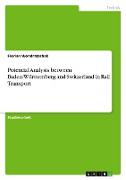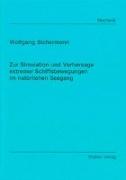- Start
- Potential Analysis between Baden-Württemberg and Switzerland in Rail Transport
Potential Analysis between Baden-Württemberg and Switzerland in Rail Transport
Angebote / Angebote:
Studienarbeit aus dem Jahr 2021 im Fachbereich Verkehrswissenschaft, Note: 2, 0, Hochschule für Wirtschaft und Umwelt Nürtingen-Geislingen, Standort Geislingen (Fakultät Wirtschaft und Recht), Veranstaltung: Research Methods, Sprache: Deutsch, Abstract: Sustainable mobility will change the future. Basic questions about how and why we get around will determine whether we achieve climate neutrality and how best to incorporate it into a society where route acceleration is a policy requirement to be considered. Rail transport is a crucial means of mobility in transport and environmental policy: the shift from road to rail goes hand in hand with a reduction in CO2, fine dust and nitrogen emissions, congestion avoidance, less land consumption and positive effects for logistics and the economy. Local public transport (SPNV) and long-distance public transport (SPFV) are regarded as high-quality, high-performance connections both between regions and for international development. In view of the increasing use of the railways, they offer the opportunity to tap new potential in rail transport and thus new target groups. Both the federal and state governments have mentioned the great importance of rail connections in their coalition agreements. Not only in the Baden-Wuerttemberg discourse is a good connection to Switzerland called for as an important building block for the future orientation of the rail transport infrastructure, but the federal governments of Switzerland and Germany have also committed themselves to this through the Treaty of Lugano. The former Swiss Transport Minister, Adolf Ogi, called the Lugano agreement "a mission for Switzerland". With the expiry of the agreement in 2021, he did not hold back in criticising Germany: "Unfortunately, our neighbour to the north has not kept to the agreement". Winfried Hermann, the transport minister of Baden-Württemberg, also shares this criticism: "We have not come close to delivering".For this reason, a potential analysis is to be prepared within the scope of this work, which will in particular reveal the current situation of the railway infrastructure between Baden-Württemberg and Switzerland. Using various criteria, an attempt is made to analyse which expansion variants could offer the greatest potential for a shift from road to rail. The study thus claims to follow up on the basic idea of the Treaty of Lugano and aims to identify possibilities for improved rail transport. In this study, the core data of the BVWP will be presented, which deal in particular with the SPFV and SGV. A potential analysis of the SPNV requires further transport engineering references, which is not part of this paper.
Folgt in ca. 10 Arbeitstagen




